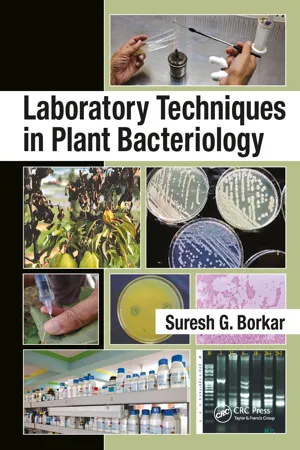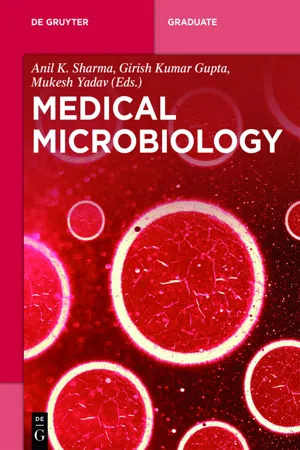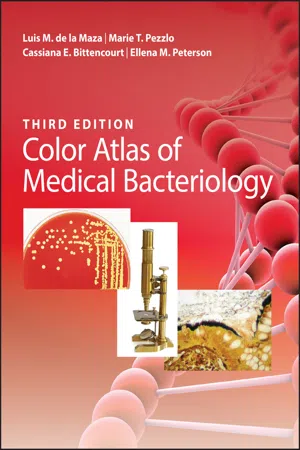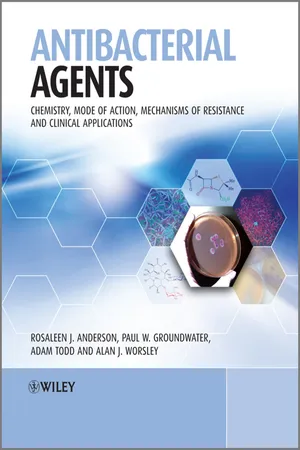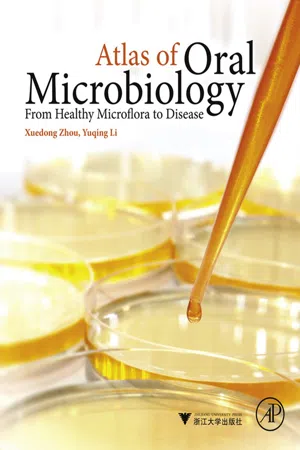Biological Sciences
Gram Stain
Gram stain is a laboratory technique used to differentiate bacteria into two groups based on their cell wall composition. It involves staining bacterial cells with crystal violet, iodine, alcohol, and safranin. Gram-positive bacteria retain the purple color, while gram-negative bacteria appear pink after the staining process. This method is widely used in microbiology to quickly identify and classify bacteria.
Written by Perlego with AI-assistance
Related key terms
Related key terms
1 of 4
Related key terms
1 of 3
11 Key excerpts on "Gram Stain"
- eBook - ePub
- Suresh G. Borkar(Author)
- 2017(Publication Date)
- CRC Press(Publisher)
The Gram Stain is a differential stain developed by Dr. Hans Christian Gram, a Danish physician, in 1884. The staining is called Gram Staining, after Dr. Gram. It is a very useful stain for identifying and classifying bacteria into two major groups: Gram-positive and Gram-negative.In this process, the fixed bacterial smear is subjected to four different reagents in the order listed: Crystal violet (primary stain), iodine solution (mordant), alcohol (decolorizing agent), and safranin (counterstain). The bacteria which retain the primary stain (appears dark blue or violet) are called Gram-positive, whereas those that lose the crystal violet and get counterstained safranin are referred to as Gram-negative.The differences in staining responses to the Gram Stain can be related to the chemical and physical differences in the bacterial cell walls. The Gram-negative bacterial cell wall is a thin, complex, multilayered structure and contains relatively high lipid content, in addition to protein and mucopeptides. The higher amount of lipids is readily dissolved by alcohol, resulting in the formation of large pores in the cell wall that do not close appreciably on dehydration of cell-wall proteins, thus facilitating the leakage of the crystal violet–iodine (CV-I) complex and resulting in the decolorization of the bacterium, which later takes the counterstain and appears red. In contrast the Gram-positive cell walls are thick and chemically simple, composed mainly of protein and cross-linked mucopeptides. When treated with alcohol, it causes dehydration and closure of cell wall pores, thereby not allowing the loss of the CV-I complex, and so the cells remain purple.Material RequiredCultures of test bacterium that are 24 or fewer hours old, Gram Staining reagents crystal violet, Gram’s iodine solution, 95 percent ethyl alcohol, safranin, staining tray, wash bottle of distilled water, droppers, inoculating loop, glass slides, blotting paper/absorbent paper, tissue paper, Bunsen burner/spirit lamp, microscope.ProcedureMake thin smears of test bacterium on glass slides. Let the smears air dry. Heat fix the smears. Hold the smears using a slide rack or clothes pin. Cover the smear with crystal violet for 30 seconds. Wash the slide with distilled water for a few seconds using the wash bottle. Cover the smear with Gram’s iodine solution for 60 seconds. Wash off the iodine solution with 95 percent ethyl alcohol. Add ethyl alcohol drop by drop, until no more color flows from the smear. (The Gram-positive bacteria are not affected while all Gram-negative bacteria are completely decolorized.) Wash the slides with distilled water and drain. Apply safranin to smears for 30 seconds (counterstaining). Wash with distilled water and blot dry with absorbent paper. Let the stained slides air dry. - eBook - ePub
- Anil K. Sharma, Girish Kumar Gupta, Mukesh Yadav, Anil K. Sharma, Girish Kumar Gupta, Mukesh Yadav(Authors)
- 2022(Publication Date)
- De Gruyter(Publisher)
10 ]. It is still the most widely employed method for visualizing bacteria.The principle for differential staining in Gram Stain lies in chemical composition of bacterial cell wall and components used in Gram Staining. In Gram Staining, four components are used (in sequence). These stains include primary stain (crystal violet) followed by mordant (iodine), thereafter, decolorizer (ethanol/acetone) and the last counterstain (safranin). Bacterial cell wall is composed of peptidoglycan. The cell wall gives rigidity, firmness and protection to the internal structure of cell. Gram-positive bacteria have comparatively thicker cell wall of peptidoglycan while the gram-negative bacteria have thin cell wall and also have an outer additional membrane based on phospholipids bilayer [12 ]. The crystal violet stain enters through the cell wall of both types of cells, but the existence of iodine–dye complex remains difficult [13 ]. In the next step, the use of decolorizer (alcohol or acetone) dissolves the lipids of membranes. The decolorizing mixture results in dehydration of cell wall, and it also serves as a solvent to wash out the crystal violet–iodine complex. In case of gram-negative bacteria, the decolorizer dissolves the outer bilayer membrane made of phospholipids. Due to dissolution of lipids, the dye–iodine complex escapes during the step of decolorization. Due to the loss of outer membrane and the crystal violet–iodine complex, the gram-negative cells are able to take the counter stain (safranin) and therefore, appear pink in color (Figure 6.4 ). In the case of gram-positive bacteria, the decolorizer dehydrates, shrinks the wall and closes the pores which prevent the leakage of dye–iodine complex; therefore, these cells appear violet or blue in color [14 ]. There are so many species that may be “gram-variable” with intermediate cell wall structure in addition to the clearly gram positive and gram negative [15 - eBook - ePub
- Luis M. de la Maza, Marie T. Pezzlo, Cassiana E. Bittencourt, Ellena M. Peterson(Authors)
- 2020(Publication Date)
- ASM Press(Publisher)
41Stains, Media, Reagents, and HistopathologyBacteria are identified in the clinical laboratory by a variety of methods, including microscopy, observation of growth characteristics, determining reactions to organic and inorganic compounds, and molecular techniques. Examination of histopathological sections can also contribute to the definitive diagnosis or exclusion of bacterial infections. This chapter presents images of the more common stains, media, and tests used in the diagnostic medical microbiology laboratory, as well as relevant histopathologic images. Gram Staining is the most widely used method for visualizing bacteria. Shown in this chapter are examples of the various sizes, shapes, and arrangements of both aerobic and anaerobic bacteria found in clinical specimens. Also included are some of the most common culture media used in the laboratory for demonstrating growth, isolation, colonial morphology, hemolysis, pigment production, and other distinguishing bacterial characteristics. The figures depict some of the key tests and histologic images that have been found to be most helpful for the detection and identification of clinical isolates.STAINS
Gram Stain
Gram Staining is one of the most important procedures in bacteriology. It is used to classify bacteria based upon their size, shape, arrangement, and Gram reaction. It was originally described in 1884 by Christian Gram; the modification currently in use was developed by G. J. Hucker in 1921. The reagents and stains used in Hucker’s modification include crystal violet, Gram’s iodine, acetone alcohol, and safranin. The figures in this section demonstrate a variety of morphotypes as well as Gram Stain reactions.Hematoxylin and Eosin Stain
Hematoxylin and eosin (H&E) stain is used routinely in histopathological sections, as it displays the tissue morphology. Hematoxylin dyes the host cell nucleus with a deep‐purple blue color, and eosin stains the host cytoplasm and the extracellular matrix with a variable degree of pink color. Microorganisms, in particular bacteria and fungi, are also stained with H&E. - eBook - ePub
An Introduction to Biotechnology
The Science, Technology and Medical Applications
- W.T. Godbey(Author)
- 2014(Publication Date)
- Academic Press(Publisher)
Figure 6.1 ). When identifying bacteria, the first delineation that is often used is whether or not the cell wall is exposed or if it is hidden by the additional outer membrane. The determination can be made by the use of the Gram Stain.Figure 6.1 Proteotypical bacteria. (Top) Gram-positive and (bottom) Gram-negative. Both cells have cytoplasms surrounded by an inner membrane made from a lipid bilayer, and both inner membranes are surrounded by a cell wall made of proteoglycan. Gram-negative cells also have an outer membrane made of lipopolysaccharide. The cell wall in Gram-negative bacteria is generally thinner than that of Gram-positive bacteria, and there is a periplasmic space between the cell wall and the inner membrane.The Gram Stain was developed by Christian Gram, a researcher in Berlin in the 1800s. He developed a procedure, using a dye, a mordant, and a counterstain to determine whether or not the bacterial cell wall was exposed. If it's exposed, the cell would be called Gram-positive, and if it is not, then the cell is termed Gram-negative. Interestingly, the Gram Stain was first described by Carl Friedlander, not by Christian Gram. Friedlander worked with Gram and alluded to the staining procedure used by his colleague in an 1883 paper concerned with pneumococci . The famous paper by Gram was published in 1884. Although Friedlander used the technology and was the first to publish with it, history has since corrected the situation by crediting Gram with the original procedure, now known as the Gram Stain.The Gram Stain is simple and only takes about 10 min to perform. The first steps are to place a bacterial sample onto a slide and fix the cells in place with heat. The sample might require dilution to help ensure a monolayer of bacteria, which is desired to allow for complete penetration of the dyes that will be used. The extracellular fluid (medium and diluent) must be removed without removing the cells, and the cells must be attached to the slide to prevent them from being washed off during the stain and rinse steps of the procedure. Heat is generally used for such fixation. The slide is gently waved over a Bunsen burner to dry the slide, and the heat will cause evaporation of the fluid as well as denaturation - eBook - ePub
- Vincent A. Fischetti, Richard P. Novick, Joseph J. Ferretti, Daniel A. Portnoy, Mirian Braunstein, Julian I. Rood, Vincent A. Fischetti, Richard P. Novick, Joseph J. Ferretti, Daniel A. Portnoy, Mirian Braunstein, Julian I. Rood(Authors)
- 2019(Publication Date)
- ASM Press(Publisher)
The Gram-Positive Bacterial Cell Wall
Manfred Rohde 1HISTORICAL BACKGROUND
In 1884, the Danish bacteriologist Hans Christian Gram developed a staining procedure to view stained bacteriaunder the light microscope (1 ). His staining method, nowadays simply called Gram Staining, discriminated between a Gram-positive and Gram-negative bacterial cell wall. He introduced a dye, gentian violet, which penetrates the cell wall and cytoplasmic membrane, thus staining the cytoplasm of the heat-fixed bacteria. After addition of iodine, an insoluble complex is formed which is retained by the Gram-positive bacterial cell wall upon addition of a decolorizer such as ethanol. Therefore, Gram-positive bacteria appear almost purple, while Gram-negative bacteria retain the dye to a lesser extent or not at all and have to be counterstained with a second dye, safranin or fuchsine, appearing pink or reddish. It is noteworthy that some mycobacteria showed an indifferent staining behavior when Gram Stained, suggesting that the cell wall of mycobacteria might be somehow different from the other two types. In the following decades, it became obvious that cell walls/cell envelopes are more diverse and that Gram Staining alone often could lead to misinterpretations of the cell wall composition.Before the early 1950s, when the chemical composition of bacterial cell walls was not known, it was speculated that chitin or cellulose, polymers recognized as providing rigid structures to other organisms, might also represent the building material of the bacterial cell wall. In 1951, experiments with a phenol-insoluble material from Corynebacterium diphtheria (2 ) revealed glucosamine and diaminopimelic acid as components of the bacterial cell wall which are associated with polysaccharides. Chemical examination of streptococcal cell wall layers highlighted the presence of amino acids and hexosamines in the cell wall extract, as well as rhamnose as a main component in Gram-positive bacteria (3 , 4 ). Systematic analyses of a number of Gram-positive bacteria identified the hexosamines glucosamine and muramic acid as major components together with three prevalent amino acids, namely, d-alanine, lysine or diaminopimelic acid, and glutamic acid. By then, a typical basic basal unit in Gram-positive cell walls was also recognized in which glucosamine and muramic acid are linked with three amino acids via a peptide bond (5 , 6 ). Gram-negative bacteria express the identical basal unit. Numerous analyses of other bacteria revealed that each bacterial genus or even species is often characterized by a distinctive pattern of amino acids, amino sugars, and sugars connected to the basic basal unit. It was believed that these differences should provide a valuable pattern to discriminate between bacterial genera/species (7 , 8 ). Over the following years other compounds of the Gram-positive cell wall were recognized, such as teichoic acids (TAs), which are polyribitol phosphates (9 - eBook - ePub
Microbial Food Safety
A Food Systems Approach
- Charlene Wolf-Hall, William Nganje(Authors)
- 2017(Publication Date)
- CAB International(Publisher)
6 Gram-Positive BacteriaKey Questions• Which Gram-positive bacteria are of most concern for microbial food safety?• What are the mechanisms by which these Gram-positive bacteria cause illness?• What are the hazards these Gram-positive bacteria present to consumers?• What controls are available to prevent foodborne illness due to these Gram-positive bacteria?The Difference Between Gram-Positive and Gram-Negative Bacteria
Hans Christian Gram was the Danish scientist who, in 1884, published a method for a staining technique to help better see bacteria in tissue samples under the microscope. An unanticipated result of this technique was a way to differentiate two major groups of bacteria based on their cell wall compositions.Bacterial cell membranes that contain thick layers of peptidoglycan are able to retain the crystal violet stain used in the method, resulting in purple- or violet-stained cells that are described as Gram positive. Bacteria that contain less peptidoglycan in their cell membranes are unable to retain the crystal violet stain after the destaining step of the procedure, and as a result of counter-staining with safranin dye appear red or pink, and are described as Gram negative. As with all microbiological testing methods, there are limitations and some bacterial species may produce Gram-variable results, indicating an ability to stain with either reaction result and not provide a clear distinctive result.Gram Staining is a preliminary test used on bacterial cultures to give clues to the identity of the species. The Gram reaction is a first clue, and then other clues like the microscopic cell morphology or shape and placement can provide other clues. The remainder of this chapter will focus on those bacterial pathogens of most concern in foods that fall under the category of Gram positive, and Chapter 7 - eBook - ePub
Handbook of Textile and Industrial Dyeing
Volume 2: Applications of Dyes
- M Clark(Author)
- 2011(Publication Date)
- Woodhead Publishing(Publisher)
Colouring biological samples is similar, in scientific principle, to textile dyeing. In both areas, dyes are added to a material with the object of dye molecule attachment, usually to a polymeric substrate. However, where in textiles the chemical make-up of the substrate is well established – cotton/cellulose, silk/protein, etc. – allowing considerable control of the resulting colour and shade, biological samples are usually a complex chemical mixture, the resulting colour and colour distribution depending on the relative proportions of different biopolymers. The proportion and distribution of these biopolymers will also vary depending on the growth phase and age of the cell.As mentioned above, the Gram Staining procedure provides the cornerstone of rapid identification of bacteria in our hospitals. The process was developed by the Dane, Christian Gram in 1884 – pioneering work in an era which was less than accepting of the ‘Germ Theory’ of disease. Such research, built upon by contemporary scientists such as Robert Koch, Paul Ehrlich and others (Leishmann, Romanovsky, Giemsa – the list is fairly substantial) eventually developed into the scientific branch of histology (Wainwright, 2003b ). Specialisms within histology include histopathology, i.e. the study of disease processes via staining, which is really what Gram and subsequent workers set out to do. Modern medical laboratory scientific officers carry out such bacterial staining routinely, alongside further biochemical testing to give information on specific strains of bacteria, particularly in terms of drug susceptibility.Biological stains thus remain of immense importance in modern medicine from the point of view of infection control. However, cell staining is much more extensive than just the differentiation of bacterial and human cells.Usually, medical microbiologists examine cell samples taken from patients. These samples normally include blood, sputum, urine, faeces or tissue swabs, depending on the disease presentation. The process then runs along the lines of ‘Is there an infective organism here? If so, what is it?’ Other disease states may not be so easy to pinpoint – for example where the problem lies in human cell differentiation. Obviously, if such differentiation is required within the live patient, there are more stringent requirements in terms of dye toxicity (q .v - David Rifkind, Geraldine Freeman(Authors)
- 2005(Publication Date)
- Academic Press(Publisher)
Bacteria are of about one micron in size – 25 000 per inch – and can be visualized only with a relatively high-powered light microscope. To be visible under the microscope bacteria must first be stained, and the most common technique used is the Gram Stain, which was devised in 1884 by Hans Christian Joachim Gram, a Danish microbiologist. In this procedure bacteria are fixed on to a microscope slide, treated with the purple dye ‘crystal violet’, plus iodine, and then washed with alcohol. Those bacteria that retain the stain after the alcohol wash are termed Gram-positive, whilst those not retaining the stain are termed Gram-negative. The unique importance and utility of this simple staining procedure is not just that it provides ready visualization of the organisms but rather that it correlates with important biological features of the species of bacteria – most notably the types of disease produced and patterns of their susceptibility to the various antibiotics.Most bacteria can be killed by heating to 150°F for thirty minutes or 161°F for fifteen seconds – the procedure used in pasteurization of milk. However, some important bacteria, notably the clostridia (which cause tetanus, gas gangrene and botulism) produce resistant spores that require steaming under increased pressure for inactivation (250°F for fifteen minutes).Some bacteria, like cells of higher organisms, require oxygen for growth; these bacteria are the aerobes . Others, however, the anerobes, will only grow in the absence of oxygen – a unique characteristic first described by Pasteur.Bacteria can be cultivated in various liquid media and on media solidified with agar, a polysaccharide derived from seaweed. The unique feature of culture on solid medium is that each individual colony which develops is derived from a single bacterial cell in the inoculum – that is, the colony is a clone .Bacteria multiply by simple binary fission, an asexual process in which a single bacterial cell divides in two. By the application of genetic techniques Joshua Lederberg showed that a sexual process of recombination between two different bacterial cells can occur. This discovery was recognized by a share of the Nobel Prize for Physiology or Medicine in 1958.- eBook - ePub
Antibacterial Agents
Chemistry, Mode of Action, Mechanisms of Resistance and Clinical Applications
- Rosaleen Anderson, Paul W. Groundwater, Adam Todd, Alan Worsley(Authors)
- 2012(Publication Date)
- Wiley(Publisher)
Section 1 Introduction to Microorganisms and Antibacterial ChemotherapyPassage contains an image Chapter 1.1 Microorganisms
Key Points- Bacteria can be classified according to their staining by the Gram Stain (Gram positive, Gram negative, and mycobacteria) and their shape.
- Most bacterial (prokaryotic) cells differ from mammalian (eukaryotic) cells in that they have a cell wall and cell membrane, have no nucleus or organelles, and have different biochemistry.
- Bacteria can be identified by microscopy, or by using chromogenic (or fluorogenic) media or molecular diagnostic methods (e.g. real-time polymerase chain reaction (PCR)).
- Bacterial resistance to an antibacterial agent can occur as the result of alterations to a target enzyme or protein, alterations to the drug structure, and alterations to an efflux pump or porin.
- Antibiotic stewardship programmes are designed to optimise antimicrobial prescribing in order to improve individual patient care and slow the spread of antimicrobial resistance.
1.1.1 Classification
There are two basic cell types: prokaryotes and eukaryotes, with prokaryotes predating the more complex eukaryotes on earth by billions of years. Bacteria are prokaryotes, while plants, animals, and fungi (including yeasts) are eukaryotes. For our purposes in the remainder of this book, we will further subdivide bacteria into Gram positive, Gram negative, and mycobacteria (we will discuss prokaryotic cell shapes a little later).As you are probably already aware, we can use the Gram Stain to distinguish between groups of bacteria, with Gram positive being stained dark purple or violet when treated with Gentian violet then iodine/potassium iodide (Figures 1.1.1 and 1.1.2 - eBook - ePub
Atlas of Oral Microbiology
From Healthy Microflora to Disease
- Xuedong Zhou, Yuqing Li(Authors)
- 2015(Publication Date)
- Academic Press(Publisher)
Chapter 2Techniques for Oral Microbiology
Abstract
This chapter describes the techniques for oral microbiology, including smear and stain techniques, isolation, incubation and identification of oral microorganisms, various microscopy techniques, oral microecology techniques, and oral microbiome techniques.Keywords
Biofilm; Incubation; Microscopy; Sequencing; Smear test; Stain test2.1. Smear and Stain Techniques
Smear test and slide stain are basic techniques for microbial identification and are primarily used for morphological observation. The combination of smear and stain is widely used in oral microbiology research to differentiate between spirochetes, bacteria, fungi, and protozoa, as well as to identify specific cellular structures including spore, capsule, flagellum, and others. Currently, some of the commonly used techniques for cellular morphology examination are direct smear test and stained smear test, including Gram Stain and Congo red stain. The procedure for smear test is shown in Figure 2.1 .Specific stains can be used to observe the specific microbial structures, including the bacterial spore, capsule, flagellum, fungal hypha, clamydospore, etc.2.1.1. Kopeloff’s Modification of Gram Stain
Gram Stain is a commonly used method for the identification of bacteria and fungi. After Gram Staining, bacterial species can be generally differentiated into gram-positive and gram-negative groups, and most clinical anaerobic microbes can be differentiated by their typical cellular morphology. In addition, Mycoplasma with their ringshape can also be identified. Kopeloff’s modification of Gram Stain is recommended by the Virginia Polytechnic Institute (VPI) for better visualization and differentiation of microbes.2.1.1.1. Mechanism
Many theories have been proposed to explain the mechanism of Gram Staining, including isoelectric point theory, chemical theory, and permeation theory. Among them, permeation theory has gained wide acceptance. It is believed that crystal violet placed on the microbe smear slides during staining interacts with aqueous iodine to form insoluble precipitates within the cell. During decolorization, alcohol and acetone can dissolve the lipid in the outer membrane and leach the precipitated dye–iodine complex out of the microbial cell. Gram-positive microbes have a thick cell wall with highly cross-linked peptidoglycans and relatively fewer lipids. Thus, gram-positive microbes cannot be easily decolorized and become deeply stained in purple. In contrast, gram-negative microbes have a thin membrane with high lipid content and little peptidoglycan. The precipitated dye–iodine complex can therefore be easily dissolved and leave the cell. As a result, the cell is stained red from the counterstain. - eBook - ePub
- Stephen P. Denyer, Norman A. Hodges, Sean P. Gorman, Brendan F. Gilmore, Stephen P. Denyer, Norman A. Hodges, Sean P. Gorman, Brendan F. Gilmore(Authors)
- 2011(Publication Date)
- Wiley-Blackwell(Publisher)
Observation of stained and wet preparations of clinical specimens (blood, pus, sputum) and isolated pure cultures of bacteria from the manufacturing environment provides rapid and essential information to guide further identification. The application of simple stains such as the Gram Stain can divide the various genera of bacteria into two convenient broad groups. The size and shapes of individual cells and their arrangement into clusters, chains and tetrads will also guide identification, as will specific stains for the presence of endospores, capsules, flagella and inclusion bodies. Examination of wet preparations can give an indication as to the motility status of the isolate, and these procedures all represent an important first stage in the identification process.8.3 Biochemical testing and rapid identificationThe differing ability of bacteria to ferment sugars, glycosides and polyhydric alcohols is widely used to differentiate the Enterobacteriaceae and in diagnostic bacteriology generally. Fermentation can be indicated by pH changes in the medium with or without gas production visualized by the collection of bubbles in inverted tubes. More specialized media examine the ability of certain strains to oxidize or reduce particular substrates. There are many hundreds of individual biochemical tests available that each separately seek the presence of a particular enzyme or physiological activity. Taxonomic studies have led to the recognition that certain of these tests in combination characterize particular species of bacteria. Various manuals such asBergey’ s Manual (Holt, 1994) and Cowan and Steel’s Manual for the Identification of Medically Important Bacteria (Barrow & Feltham, 2004) provide a logical and sequential framework for the conduct of such tests. Identification of particular species and genera by such processes is time-consuming, expensive and may require numerous media and reagents.This process has become simplified in recent years by the development of rapid identification methods and kits. The latter often use multiwell microtitration plates that can be inoculated in a single operation either with an inoculated wire or with a suspension of a pure culture. Each individual well contains the medium and reagents for the conduct of a single biochemical test. Identification kits vary in their complexity and also in the precision of the identification made. Simple kits may perform only 8–15 tests, more complex ones are capable of performing 96 simultaneous biochemical evaluations. Scoring of each test and entry into a computer database then allows the pattern of test results to be compared with a large panel of organisms and a probability of identity calculated. As different sets of tests will be required for different classes of bacteria, guidance as to the initial choice of kit is given on the basis of the Gram Stain reaction, and the results of oxidase and catalase tests performed directly on isolated colonies. In large diagnostic laboratories and in quality assurance laboratories automated systems are deployed that can inoculate, incubate and analyse hundreds of individual samples at a time.
Index pages curate the most relevant extracts from our library of academic textbooks. They’ve been created using an in-house natural language model (NLM), each adding context and meaning to key research topics.
Explore more topic indexes
Explore more topic indexes
1 of 6
Explore more topic indexes
1 of 4
